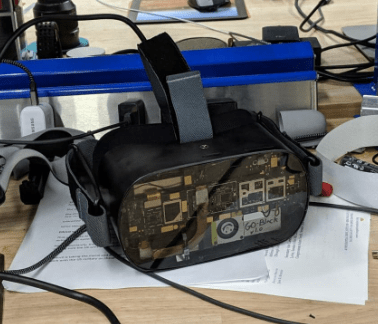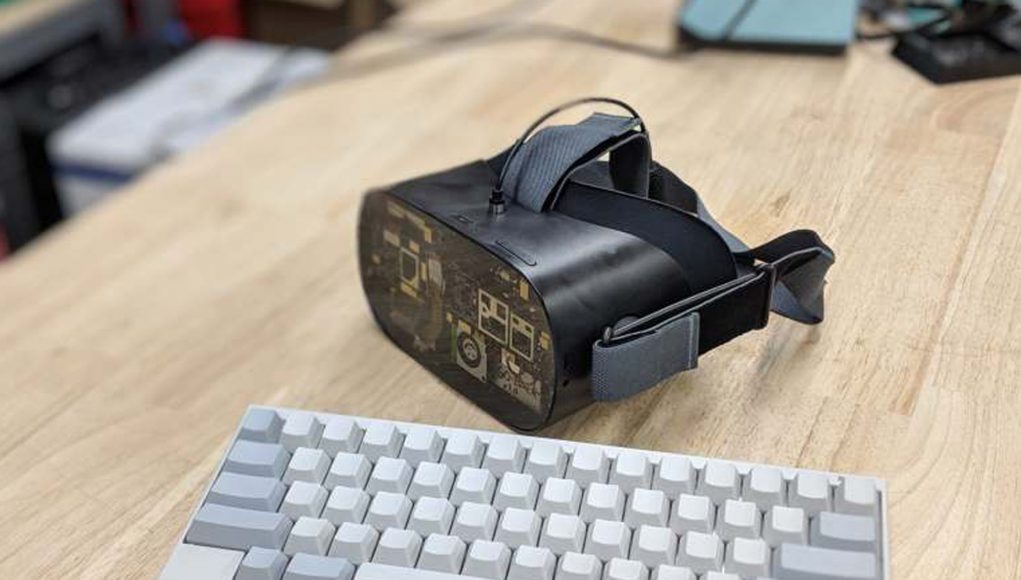Oculus co-founder Palmer Luckey may have left Facebook in 2017, but as the designer behind the Oculus Rift and its two developer kits, he has unique insight into what makes VR headsets tick. In his latest project, he’s whittled down a few of Oculus Go’s pain points into a project he calls Oculus ‘GoBlack’.
Luckey began modding Go sometime after he posted a tear-down of the headset, which revealed a standard 2,600mAh 18650 lithium-ion cell inside. At the time, he concluded the battery would be “an easy upgrade.”
Now, Luckey has gone a few steps further in a new blog post by providing a brief look at some of the changes he made to the $200 standalone headset, which include a new all-black color scheme, reduced weight, and better battery.
“[T]he resulting device is a huge step up in terms of overall experience,” Luckey says.
While he contends “anyone with a bit of technical skill can make [Oculus Go] even better,” you might want to see some of the mods first before you dust off your spudger and boil up a batch of black polyester dye.
Instead of painting it and potentially adding on more weight, Luckey stripped the unit down to its shell, facial interface, and head strap and dipped it all in a near-boiling vat of black polyester dye.

Whatever your hardware hackery skill level, Luckey issues a pretty big proviso worth noting first:
WARNING: Be careful if you try this yourself. Dying plastics requires high temperature near-boiling liquid solutions, and if you go even a few degrees too hot, you will warp your plastics almost instantly. If you go too cool, the dye won’t permeate properly. Also, you can burn yourself.
While it’s clear a darker facial interface is the most important part here, as it helps defuse reflected light and deliver a better visual experience, the all-black exterior is undeniably cool too.

Weight was also a big issue that needed addressing; the ‘face-borne’ body of the headset weighs just over 400 grams—lighter than the Oculus Rift. Go is pretty front-heavy though, which can create discomfort by putting pressure on your face.
Luckey has however whittled it down to 280 grams by relocating the battery and replacing the headset’s stock passive cooling system with a custom one which uses a shorter and lighter heat pipe, small aluminum fins, and electric mini-blower that draws power from the main board.

Replacing the aluminum faceplate with a lightweight plastic and tearing out the internal shielding only saves a couple of grams however, Luckey contends, but the aesthetics were just too cool to pass up.
Because Go’s stock 2,600mAh battery normally sits inside the headset, it makes up about 10% of that 400 gram curb weight mentioned above. Luckey has however relocated the battery to the back of the head strap with a Velcro compartment and entirely replaced it with a 3,500mAh cell, adding an hour of playtime to the headset’s stock two-hour battery life.

Another fine touch: the power cable actually houses a magnetic pogo-pin connector, which allows you to hot-swap battery packs.
“Totally subjectively, it feels like a 50% weight reduction, especially during head movement,” Luckey concludes.
He did try his hand at adding an interpuppilary distance (IPD) adjuster, which is sorely lacking in Oculus Go. This proved to be more difficult than previously thought though—a sad revelation considering Luckey’s IPD is on the high side.
“I have a pretty wide interpupillary distance, around 70mm, and Oculus Go is somewhat unusable for me […] The VR revolution should be accessible for everyone, no matter the distance between their eyes. I will be writing more on this in the future.”
– – — – –
If you’re looking for a good place to start on your Oculus Go modding adventure, check out MindTribe’s detailed tear down. Yes, you’ll be voiding your warranty.
Also, in case you missed it, check out Palmer Luckey’s blog for the full rundown of his ‘GoBlack’ mod.







